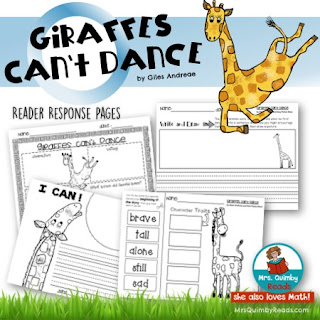You might hear them say, “Math is hard, but if I keep trying, I can get better at it.” The research states that those students who acquire a growth mindset perform better that students with a fixed mindset and they significantly outscore them in the areas of math and literacy. Growth mindset learners recognize the importance of effort in academic success. They seek out challenging academic tasks to enhance their learning and they value critical feedback.
Some ways you might develop growth mindset in your classroom:
1. Read books with characters who face challenges and develop strategies to overcome them.
 |
| Reader Response Pages HERE |
2. Practice phrases that promote growth mindset. Openly discuss things students, with a fixed mindset, might say (i.e., "I can't do this" or "This is too hard"). Brainstorm alternatives (such as, "What other strategies can you try?" "You can't do this yet, but you will." or, "It may take some time but I know I can do it.")
3. Display visible reminders of growth mindset vocabulary using inspirational posters and bulletin boards. Anchor charts from the activity above make great classroom reminders. Students might design their own motivational posters to encourage authentic learning. Bulletin boards may focus on the overall understanding of a growth mindset, or feature words and phrases associated with the positive attributes or actions of characters in literature. Boards might feature athletes, business leaders and even Presidents who have overcome challenges. Knowing the stories of these individuals can be extremely inspiring. Most successful people have had obstacles to overcome. They worked hard and made many trials before reaching their goal.
 |
| Growth Mindset Posters for Your Classroom Find Your Set HERE
4. Students need to learn early on that learning new things does not always come easy. Learning requires hard work, effort and perseverance. Encourage students to not give up when things become difficult and tell them that if they can't do something now, it doesn't mean they never will. You might say "You can't do this YET, but keep going!" A perfect read aloud story to use as a springboard for this growth mindset is Giraffes Can't Dance. Gerald can't dance but he perseveres and finally does so!
5. Provide Group Learning Opportunities. Children learn by cooperating in groups that their efforts and participation results in the success of a group. Their sense of responsibility for their group's performance will spur them on to try their best. When they are successful with the completion of the activity, they build confidence which carries over to other learning situations. Group Projects like the one below is an example of how you might incorporate growth mindset with content and curriculum.
Pilgrim -Wampanoag Group Project
Cooperation and Collaboration
6. When giving feedback to your students, use prompts that facilitate a growth mindset. Rather than saying "Good Job!" you can encourage higher introspection with prompts that ask questions about the student's process in learning. (i.e. "What made you decide to try that method?"), how they might work to improve ("What do you think you might do differently next time?"), and what they learned from their mistakes ("When x occurred, how did you feel and what dis you learn from that?"). By providing the opportunity for self-evaluation, students will discover more about their ability to work through to a solution. They will learn 'self-talk' approaches and questions to ask themselves in future learning situations.
7. Model growth mindset as a teacher. We are role models for learning. When you are faced with a challenge or make a mistake, talk through the situation with your students to demonstrate the path to learning. You will be helping your students to make important connections to real-life situations. For example, if you waited too long to reserve a common learning space for a special project, you might ask for input from your students. They might suggest combining with another group or using an outdoor area. Involving your students helps them to recognize that everyone makes mistakes and it is important to find solutions to make progress. Being flexible can be a great aptitude in many learning situations.
Creating an environment that promotes a growth mindset can improve literacy and math achievement and it can also develop the life long learning skills we strive for in our academic journey.
|






